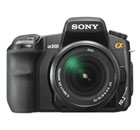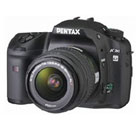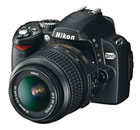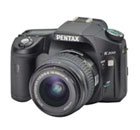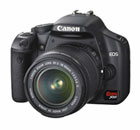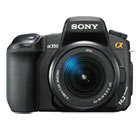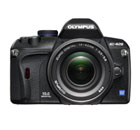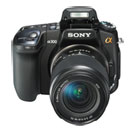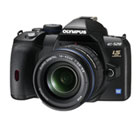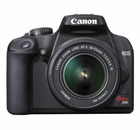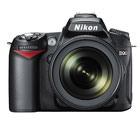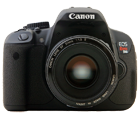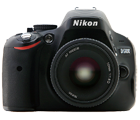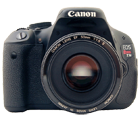The New Digital SLR Cameras of 2008 |
Page updated: September 2008 |
This introduction to the new digital SLR cameras of 2008 is intended for anyone who is on the verge of a new digital SLR purchase, but is concerned about the camera becoming obsolete within a few months.
This page has three primary goals:
- You can find out about all of the new models that will be released this year
- You'll learn how the new models improve upon the older cameras
- You'll see how the different cameras of 2008 compare to each other
Clearly, this will be a work in progress - as new cameras are announced and release dates are set, I'll add the information to this page.
This should give you a broad perspective on all the new digital SLR cameras of 2008, and might just prevent you from buying a camera today, only to wish you'd waited just a few months more to take the plunge.
2008 Digital SLR Timeline
Let's begin with the basics: here's a timeline that includes the release dates for each one of the recently announced cameras:
| CAMERA MODEL | RELEASE DATE |
|---|---|
| Sony Alpha DSLR-A200 | February 29 |
| Pentax K20D | Early March * |
| Nikon D60 | March 29 |
| Pentax K200D | April 1 |
| Canon Rebel XSi (450D) | April 15 |
| Sony Alpha DSLR-A350 | April 25 |
| Olympus E-420 | May 20 |
| Sony Alpha DSLR-A300 | May 25 |
| Olympus E-520 | August 10 |
| Canon Rebel XS (1000D) | August |
| Nikon D90 | September 8 |
| Canon 50D | October 10 |
| Canon 5D Mark II | November |
* Originally set for release in May, the K20D was actually released in March
Besides the obvious crush of new camera relases right before the Spring (April was a fun month), you'll also notice a surge in the number of Sony digital SLRs.
In 2006, when Sony first started production of digital SLR cameras, they made it clear that it was their intention to become a dominant player in the digital SLR camera market.
2007 saw the release of only one new Sony digital SLR: the DSLR-A700, which was geared more for semi-professional photographers rather than consumers.
Clearly things are going to be different in 2008, and we'll get into some of the new features that the A200, A300 and A350 bring to Sony's line of digital SLRs in just a moment.
New Cameras: The Features
Let's kick off this review of the new digital SLR cameras of 2008 with an introduction to their primary features.
Please realize that these are the high-level features - as the cameras are released, I will add links to more in-depth guides that will give you a better sense of how the camera performs and operates.
The cameras are listed in the order that they'll be released.
Sony Alpha DSLR-A200
The DSLR-A200 is Sony's third digital SLR camera (the second was the more advanced DSLR-A700) and represents a relatively minor upgrade over the original DSLR-A100.
|
Release Date: February 29, 2008
Approximate Cost (with lens): $700
|
Pentax K20D |
Coming in with just a few more megapixels than the Sony A350, the K20D is also the only Pentax digital SLR camera with a live view LCD, and it features an extended ISO range that goes all the way up to 6400.
|
Release Date: March 2008
Approximate Cost (with lens): $1,380
|
Nikon D60 |
The D60 is an upgrade to the D40x and continues Nikon's trend of developing small, lightweight and inexpensive cameras for beginning digital SLR photographers.
|
Release Date: March 29, 2008
Approximate Cost (with lens): $750
|
Pentax K200D
What sets the K200D apart from other cameras in its price range is that the camera body is sealed against weather and dust - assuring that you can continue taking photos even when the weather turns foul.
|
Release Date: April 1, 2008
Approximate Cost (with lens): $700
|
Canon Rebel XSi (450D) |
The Canon XSi is slightly faster and has a larger LCD than its competition, all in a compact lightweight package. The kit lens included with the camera features Canon's Image Stabilization (IS).
|
Release Date: April 15, 2008
Approximate Cost (with lens): $900
|
Sony Alpha DSLR-A350
Designed for enormous print sizes, the A350 will be the first Sony to include a live view LCD that flips out from the camera body for high and low-angle photography.
|
Release Date: April 25, 2008
Approximate Cost (with lens): $1,000
|
Olympus E-420
The successor to the already small and light E-410 is the new Olympus E-420 - billed as the smallest and lightest digital SLR camera money can buy. In addition to its diminutive frame, the E-420 includes a dust control system, live view LCD, face detection autofocus and extended dynamic range. It does NOT include the built-in image stabilization available in the Olympus E-510.
|
Release Date: May 20, 2008
Approximate Cost (with lens): $600
|
Sony Alpha DSLR-A300
The A300 is simply a less expensive 10 megapixel version of the A350 - it includes that camera's live view LCD screen that flips out from the camera body.
|
Release Date: May 25, 2008
Approximate Cost (with lens): $900
|
Olympus E-520
The follow-up to the popular Olympus E-510 includes the addition of face detection autofocus, improved capture of high-contrast scenes and an enhanced live view mode. All of these features are packed into a compact frame, which makes the E-520 much more portable.
|
Release Date: August 10, 2008
Approximate Cost (with lens): $700
|
Canon Rebel XS (1000D)
The Canon Rebel XS is really just a simpler version of the XSi (and an improved version of the xTi) that borrows features from both cameras with a reduced price tag to entice photographers on a budget.
|
Release Date: August, 2008
Approximate Cost (with lens): $700
|
Nikon D90
The Nikon D90 not only improves significantly upon the features available in the older D80, it also packs in a first: the D90 is the first digital SLR on the market that also lets you capture High Definition (HD) video. When paired with the new 18-105mm Vibration Reduction lens, the D90 kit is worthy of note.
|
Release Date: September 8, 2008
Approximate Cost (with lens): $1,300
|
Canon 50D
The follow-up to the popular Canon 40D features a variety of improvements, including a higher resolution LCD screen, enhanced live view mode with face detection autofocus, an HDMI output (to connect directly to a flat panel TV), improved exposure control, and the inevitable increase from 10 megapixels to 15.
|
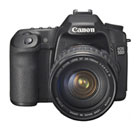 Release Date: October 10, 2008
Approximate Cost (with lens): $1,600
|
New Cameras: The Extras
There are four big features that have recently emerged in digital SLR cameras that the manufacturers are using to help set their cameras apart.
These features are: image stabilization, dust control sensors, live view LCD screens and extended dynamic range.
Image Stabilization (IS)
Image stabilization systems help you capture clearer photos when you're using long telephoto lenses (200mm or more) or when you're using slow shutter speeds in low light and don't have a stable surface for the camera.
Both telephoto lenses and slow shutter speeds enhance camera shake and lead to very blurry photos.
Canon and Nikon have been including stabilization systems in their lenses for years, but a recent trend is to add the stabilization to the camera BODY, so that it works with every lens that's compatible with the SLR.
Since Canon and Nikon have already invested a lot of effort in their IS lenses, it's unlikely that either will follow this trend any time soon - you'll find that new camera models released by these companies are paired with kit lenses that include IS.
Learn more about Image Stabilization
Dust Control Sensors
Without a dust control system, dust can contaminate the digital sensor of your SLR camera and will be evident as little black spots in every photo you take.
Dust isn't a problem with compact digital cameras since you can't change the lens.
With an SLR, dust can enter the camera body every time you remove the lens to exchange it for another.
Rare a year ago, dust control systems are now quite common on new digital SLR cameras: they repel and/or shake off any dust particles that enter the camera body and try to land on the digital sensor.
Live View LCDs
If you've ever used a compact digital camera, you've used a live view LCD: the LCD shows you a "video" preview of the photo you're about to take.
For many years, a similar feature was missing on digital SLRs: the only way to compose photos was to look through the viewfinder.
While you could use the LCD to review photos and change menu settings, you couldn't use it as an alternative to the viewfinder.
Today, the tide is turning and "live view" LCD screens are appearing on more and more new digital SLRs.
Learn more about Live View LCDs
Extended Dynamic Range
Dynamic range enhancement is a fairly new feature of digital SLR cameras, but is gaining in popularity.
Imagine you're taking a photo of someone wearing a white jacket standing next to someone wearing a black jacket on a bright sunny day.
There is a wide range of contrast from black to white and digital SLRs can't capture the entire range: either the white jacket will lose detail (appearing as pure white) or the black jacket will (appearing as pure black).
Digital SLR cameras that feature "extended dynamic range" attempt to compensate for this either by limiting the brightness of highlights or by increasing the brightness of shadows to create a more balanced image.
Now that we've covered the basics of each one of these new features, let's take a look at which ones the new digital SLRs of 2008 include:
| IMAGE STABILIZATION | DUST CONTROL | LIVE VIEW | EXT. DYNAMIC RANGE | |
| Canon Rebel XSi | With kit lens | |||
| Canon 50D | With kit lens | |||
| Nikon D60 | With kit lens | |||
| Nikon D90 | With kit lens | |||
| Olympus E-420 | None | |||
| Olympus E-520 | Built in | |||
| Pentax K200D | Built in | |||
| Pentax K20D | Built in | |||
| Sony DSLR-A200 | Built in | |||
| Sony DSLR-A300 | Built in | |||
| Sony DSLR-A350 | Built in |
New Model / Old Model
This section will help explain some of the improvements the new digital SLR cameras of 2008 have made over cameras released in previous years.
While last year's camera model - like last year's fashions - can be sometimes hard to find, you can get a great discount if you don't need all the bells and whistles available on the latest model.
For existing digital SLR owners, this section hopes to answer the question: is it worth it for me to upgrade my old camera to one of these new ones?
Canon XSi / xTi
Besides the obvious increase in megapixels (from 10 to 12) the Canon XSi includes some other enhancements over its little brother.
A significant change has to do with how the camera stores photos: the memory card.
All other Canon digital SLRs use Compact Flash cards, but the Rebel XSi uses the smaller SD memory card: bad news for anyone who's invested a lot in Compact Flash (like me) but great for people with compact digital cameras that use the same memory media.
The XSi is compatible with SDHC cards (SD High Capacity) which is a good thing since 12 megapixel files can eat up a lot of space - if you want to take photos for an extended period of time, the high capacity card is a real benefit.
The XSi is the first digital Rebel to include a live view LCD, the standard kit includes an image stabilized lens and the camera has extended dynamic range. In short: the XSi covers every single additional feature you can have on a digital SLR, making it more suitable for a wide range of photographic opportunities.
The XSi also gets a slight boost in its continuous capture rate: up to 3.5 photos per second from 3 (on the Rebel xTi).
Bottom Line: get the Rebel XSi over the xTi if you'd like the convenience of a live view LCD, already have a compact camera that uses SD memory cards, or want a camera package that includes an image stabilized lens.
Nikon D60 / D40x
The key enhancements that the D60 features over the D40x are easy to summarize in a short list:
- Addition of a new dust control system
- Uses Nikon's EXPEED system for quick image processing
- Includes Active D-Lighting: Nikon's term for extended dynamic range
- Can create stop-motion animation from a sequence of images
- New kit lens includes image stabilization (which Nikon calls Vibration Reduction or VR)
Bottom Line: if you're looking for dust control, extended dynamic range and lens-based stabilization, then the D60 is a better choice than the D40x.
Nikon D90 / D80
The new Nikon D90 isn't really an upgrade to the D80: it's a complete paradigm shift.
First, the D90 includes all of the new "extra" features that the D80 lacks: a dust control system, live view LCD, an image-stabilized kit lens and enhanced dynamic range.
The icing on the cake is that the D90 is the first digital SLR to break the movie barrier - allowing you to capture High Definition videos with the same 12.3 megapixel sensor that captures still images.
The D90 further expands the gap between the older D80 in image quality: the D90 produces exceptionally low noise even at very high ISO settings - providing photographers with a lot of flexibility when shooting with available light.
Bottom Line: if want a digital SLR that does it all, then the D90 is the camera to consider.
Sony A200, A300, A350 / A100
Early adopters of the Sony A100 now have a lot of upgrade alternatives to choose from.
More importantly, anyone with a few old Konica Minolta film SLR lenses - which are compatible with all Sony digital SLRs - now can choose between four different camera models (five, if you coun the high-end A700) rather than just one.
Let's take a quick comparative look at what each one has to offer:
| A100 | A200 | A300 | A350 | |
| Megapixels | 10.2 | 10.2 | 10.2 | 14.2 |
| Photos / Sec | 3 | 3 | 3 | 2.5 |
| Dust Control | Yes | Yes | Yes | Yes |
| Dynamic Range | No | Yes | Yes | Yes |
| Image Stabilization | Yes | Yes | Yes | Yes |
| Live View | No | No | Yes | Yes |
| LCD Size | 2.5 in. | 2.7 in. | 2.7 in. | 2.7 in. |
| Flip-out LCD | No | No | Yes | Yes |
| Cost (with lens) | $700 | $700 | $900 | $1,000 |
It's true - all of these cameras are quite similar to each other.
There are some key differences to pay attention to: both the A300 and A350 offer a live view LCD where the LCD flips out from the camera body, making it easy to compose photos from above your head or down around your waist.
If you don't think you'll ever really leverage this feature, then save some money and go with the A200 or A100. I'd recommend the A200, just because it offers some functional improvements over the original A100.
When comparing the A300 and A350, just remember this: cameras with more megapixels don't take BETTER pictures. More megapixels just means you can print at larger sizes and it gives you more leeway to crop out parts of your photos.
Bottom Line: 10 megapixels is more than enough for the armchair photographer, so only spring for the A350 if you're positive you'll be making poster-size prints.
Olympus E-520 / E-510
Since the E-510 was groundbreaking - the first to feature a dust control system, live view LCD and built in image stabilization all in one camera - the E-520 has a lot to live up to.
The big differences between the E-520 and E-510 are subtle ones, but potentially important depending upon your photography style.
- Improved Live View - the E-510 uses what's become a common implementation of live view: in order to autofocus in live view mode, you can't use the same button as you do when you're using the viewfinder. The E-520 changes this so that the transition from viewfinder to live view mode is much more seamless.
- Face Detect Autofocus - this common feature on compact cameras is now finding its way to digital SLRs. The autofocus system is designed to recognize faces and will immediately set autofocus for the faces rather than competing elements in the foreground and background.
- Extended Dynamic Range - the E-520 automatically brightens shadows in your photos to create images where there's more balance between shadows and highlights.
- Wireless Flash - the E-520 can trigger multiple FL-50R and FL-36R flash units without the use of any connecting cords
- Underwater Housing - for those who want to take their digital SLRs under the waves, Olympus is releasing a PT-E05 underwater housing for the E-520
Bottom Line: if you take a lot of portraits, capture photos in high-contrast light, or need an SLR to take photos when you dive, then the E-520 is a better option than the E-510.
Pentax K200D / K100D
The K200D is quite similar in many ways to the K100D...only better.
If you compare the specs side by side for the two cameras you won't see a lot of huge changes. The K100D was an inexpensive SLR with a good feature set, and the K200D just builds on top of that.
The most notable improvement is that the camera is sealed against weather and dust which means you can use it in a rainfall and at the beach without worrying about damaging it. Weather sealing is quite common on semi-professional camera models like the Canon 40D, Nikon D300 and Olympus E-3 but it's extremely rare for digital SLRs in this price range.
Pentax also upgraded their dust control system in the K200D with a new Dust Alert feature that shows you where dust particles may be adhering to the sensor.
Also new on the K200D is a feature that's now quite common on other digital SLRs: the ability to customize the way the camera captures color when images are being saved as JPG files. Options include Natural, Bright, Portrait, Landscape, Vivid and Black and White.
Finally, if you want to go on a longer trip with your camera and don't mind extra size and weight, the K200D is compatible with the new D-BG3 battery grip. The grip not only allows you to take more photos before having to recharge the batteries, it also includes additional camera controls to make taking portrait photos more ergonomic and comfortable.
Bottom Line: if you take lots of photos in bad weather or want a camera whose stabilization system works with virtually every Pentax lens ever made, then the K200D is the least expensive choice.
Pentax K20D / K10D
Even thought the K10D was a solid camera that took great photos, the K20D improves upon it in several different ways.
First there's the additional features: a live view LCD screen and extended dynamic range. The first is useful for anyone who enjoys composing photos without peering through the viewfinder, while the other is suitable for photographers who often take photos that have a wide range of contrast.
Another major addition is the brand new 14.6 megapixel CMOS sensor, developed in partnership with Samsung. Paired with noise-reduction technology and a built in image stabilization system, this should be a good camera for low-light hand-held photography.
The K20D is the only camera of this group with a true pentaprism for the viewfinder instead of a pentamirror which makes the camera heavier but should yield a (slightly) clearer image in the viewfinder.
Another interesting enhancement on the K20D is the ability to quickly shift between program, aperture priority and shutter priority mode, simply by turning a command dial (on every other SLR this change is made by rotating a knob on the top of the camera).
Bottom Line: if you want to make enormous prints and are looking for an SLR with stabilization, dust control, a live view LCD and extended dynamic range then the K20D should be on your list.
Cameras Compared
As I state in Step 1 of my camera-buying guide, the most important thing for you to figure out before you start comparing cameras left and right is: what do you love to photograph?
The subjects that you photograph the most will determine the camera features that you really can't live without.
Once you know what those features are, then it's relatively easy to find a digital SLR camera that's a good match to your photography style.
For example: let's say that you really enjoy taking photos of your children indoors, but they move around a lot. In this case you need to use a fast shutter speed to freeze their motion and get clear photos - an image stabilization system won't help out in this case, since IS only helps to counteract CAMERA shake.
What you really need is a camera with good high ISO performance so that you can increase the ISO, make the sensor more sensitive to light, and subsequently increase your shutter speed to get clear shots.
Just one problem - ALL of the cameras that I've listed here have great high ISO performance. But if you're really paying attention to the specs, you'll notice that the Nikon D60, and all the Sony SLRs have a little more range (going up to ISO 3200). The Pentax K20D beats them all with ISO 6400, but it's quite likely that you'll see a TON of noise at this setting.
Let's now add in a second element: not only do you take a lot of photos indoors, but you really don't want to be down on the floor all the time to photograph your kids at eye level.
In this case, you need an SLR with live view AND an LCD that flips out from the camera body so it's easy to see even when you hold the camera at waist level. The two best options are clear: the Sony DSLR-A300 or the DSLR-A350.
See how this works?
Once you know WHAT you want to photograph, it's much easier to narrow down the alternatives to find the camera that best meets your needs.
| IF YOU WANT... | THEN CONSIDER... |
|
|
|
|
|
|
|
|
|
|
|
|
|
|
|
|
|
|
|
|
|
|
There's also one other way to compare and contrast the digital SLRs of 2008: be aware of what they DON'T have and consider how these limitations might affect your photography in the future.
The following table lists out some of the elements missing from each SLR.
A note: this does not meant that the camera is BAD or that it won't take decent photos. They ALL will. It just means that the camera may not have some feature that's captured better on a different model.
| CAMERA | LIMITATIONS |
| Canon Rebel XSi 450D | The only real limitation of the XSi is that it doesn't have built-in image stabilization. While the camera does come packaged with an IS lens, if you ultimately want to buy OTHER lenses for it, you'll have to pay a premium since stabilized lenses cost more than their non-IS counterparts. |
| Nikon D60 | The D60 - like the D40 and D40x before it - only works with a limited number of lenses with built-in autofocus motors (called AF-S or AF-I lenses). If you get a non AF-S or AF-I lens it can be attached to the camera, but autofocus will be disabled. This reduces the compatibility of this camera with a wide range of great Nikon and third party lenses that don't have AF-S. |
| Olympus E-420 | Even though it's packed with other features, the E-420 does not include a built-in image stabilization system, nor are there any Olympus lenses with stabilization. If this feature is high on your list of must-have's, then the E-420 is not the right SLR for you. |
| Olympus E-520 | The sole limitation of the E-520 is that - like other modern Olympus digital SLRs - it's only compatible with the new 4/3 lenses and won't work with legacy Olympus film lenses. |
| Pentax K200D | While inexpensive, the K200D lacks a live view LCD. If this feature is important to you, then consider the Canon XSi, Pentax K20D or one of the Sony digital SLRs. |
| Pentax K20D | What's the one drawback of a camera that's got it all? Not everyone needs to capture 14.6 megapixel photos: they will eat up your hard drive space, require a powerful computer to view and edit and will take a long time to upload to an online gallery. |
| Sony DSLR-A200 | The most obvious omission in the A200 is a live view LCD, but it also doesn't have the flip-out LCD that will soon be available on the A300 and A350. If you're into high and low-angle photography, this camera isn't the best choice. |
| Sony DSLR-A300 | There really aren't any obvious limitations of the A300 at this point in time. It's got every feature in the book, and its 10.2 megapixel sensor is fairly standard these days. Only time - and testing - will reveal if this camera has a weakness relative to its competition. |
| Sony DSLR-A350 | The A350 has the same issue as the Pentax K20D: the size of the 14.2 megapixel files it captures can be a real drag on a computer system that's not top-of-the-line. |
On the flip side of things, each one of these new digital SLRs of 2008 also comes with its advantage:
| CAMERA | ADVANTAGES |
| Canon Rebel XSi 450D | The camera that came before this one - the Rebel xTi - was the most popular camera for the entire year of 2007. Thousands of photographers can't be wrong. |
| Nikon D60 | If you like the Nikon brand but don't want a huge camera to lug around then the D60 is optimal - it's the smallest and lightest Nikon digital SLR. |
| Olympus E-420 | The E-420 can be summed up in three words: small, light and inexpensive. It also seems that the E-420 will be a great transition camera for anyone moving up from a compact point-and-shoot. |
| Olympus E-520 | The E-520 packs a huge number of features into a compact camera that is priced for the photographer who wants a lot of bang for the buck. |
| Pentax K200D | The K200D has two leasts: it is the least expensive camera to also include weather sealing and one of the least expensive that has a built-in image stabilization system. Great value for money. |
| Pentax K20D | If you want to make massive prints and want a camera that has all the extras plus a durable weatherproofed frame then the K20D is the clear choice. It has the most megapixels (just barely) of any other camera in its class. |
| Sony DSLR-A200 | The A200 is a camera that's equivalent in many ways to the A300, but lacks the live view flip-out LCD. If that's not really important to you, save a couple of hundred dollars and pick up an A200. |
| Sony DSLR-A300 | Remember how I said there were few limitations of the A300? That's also its greatest advantage. |
| Sony DSLR-A350 | All the features of the A300, plus that gigantic sensor: this is the best option for those who like what Sony has to offer and also want to make large prints of their photos. |
Packages and Prices
Whether you want no lenses, one lens, or a couple to go with your camera, there's a package out their to suit your needs. Naturally, the price goes up the more you get.
| CAMERA | PACKAGE | AVG. U.S. PRICE |
| Canon Rebel XSi | ||
| Black camera body only | $800 | |
| Silver camera body only | $800 | |
| Black with 18-55mm f/3.5-5.6 IS lens | $900 | |
| Silver with 18-55mm f/3.5-5.6 IS lens | $900 | |
| Nikon D60 | ||
| Camera body only | $630 | |
| With 18-55mm f/3.5-5.6 VR AF-S lens | $750 | |
| With 18-55mm f/3.5-5.6 AF-S DX VR and 55-200mm f/4-5.6 ED IF AF-S DX VR lenses | $1,000 | |
| Nikon D90 | ||
| Camera body only | $1,000 | |
| With 18-105mm f/3.5-5.6G ED AF-S VR DX lens | $1,300 | |
| Olympus E-420 | ||
| Camera body only | $500 | |
| With 14-42mm f/3.5-5.6 lens | $600 | |
| With 25mm Pancake lens | $700 | |
| Olympus E-520 | ||
| Camera body only | $600 | |
| With 14-42mm f/3.5-5.6 lens | $700 | |
| Pentax K200D | ||
| Camera body only | $700 | |
| With 18-55mm f/3.5-5.6 lens | $800 | |
| Pentax K20D | Camera body only | $1,300 |
| Sony DSLR-A200 | ||
| With 18-70mm f/3.5-5.6 lens | $700 | |
| With 18-70mm f/3.5-5.6 lens and 75-300mm f/4.5-5.6 lens | $900 | |
| Sony DSLR-A300 | ||
| With 18-70mm f/3.5-5.6 lens | $800 | |
| With 18-70mm f/3.5-5.6 and 55-200mm f/4-5.6 lenses | $1,000 | |
| Sony DSLR-A350 | ||
| Camera body only | $800 | |
| With 18-70mm f/3.5-5.6 lens | $900 | |
| With 18-70mm f/3.5-5.6 and 55-200mm f/4-5.6 lenses | $1,100 |
Related Links
Canon Rebel XSi 450D
Nikon D60
Olympus E-420
Olympus E-520
Pentax K200D and K20D
Sony DSLR-A200, DSLR-A300 and DSLR-A350
| Digital SLR Home |
